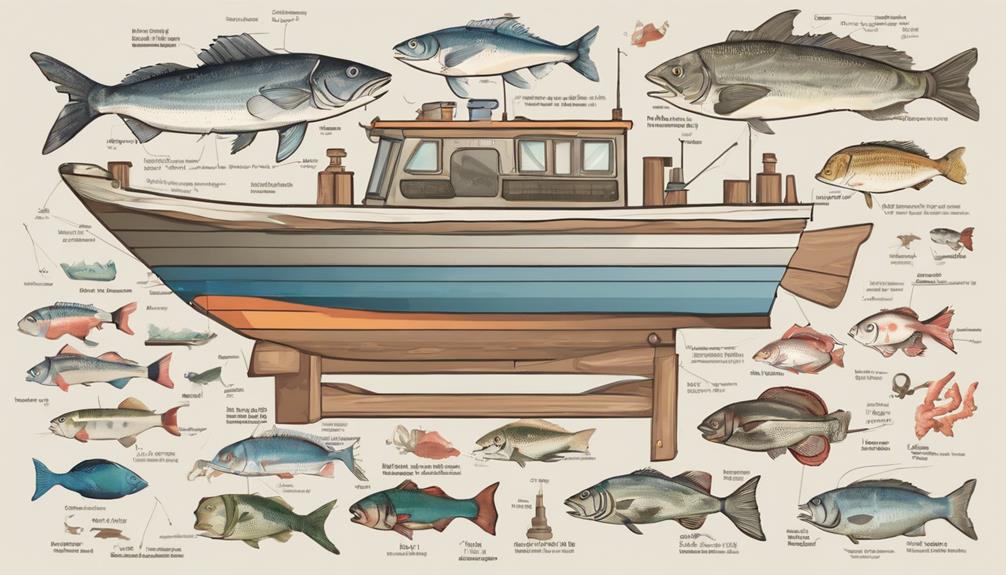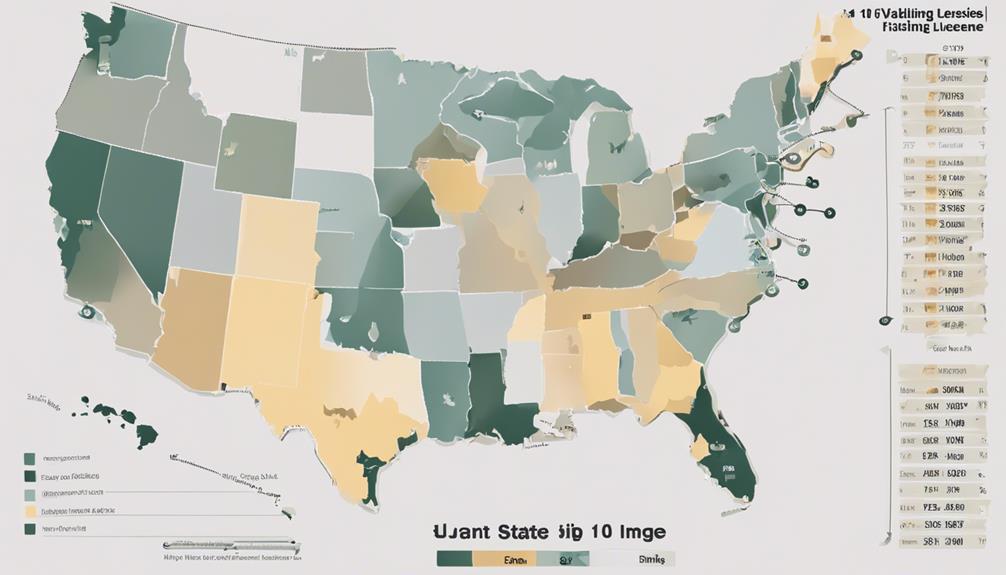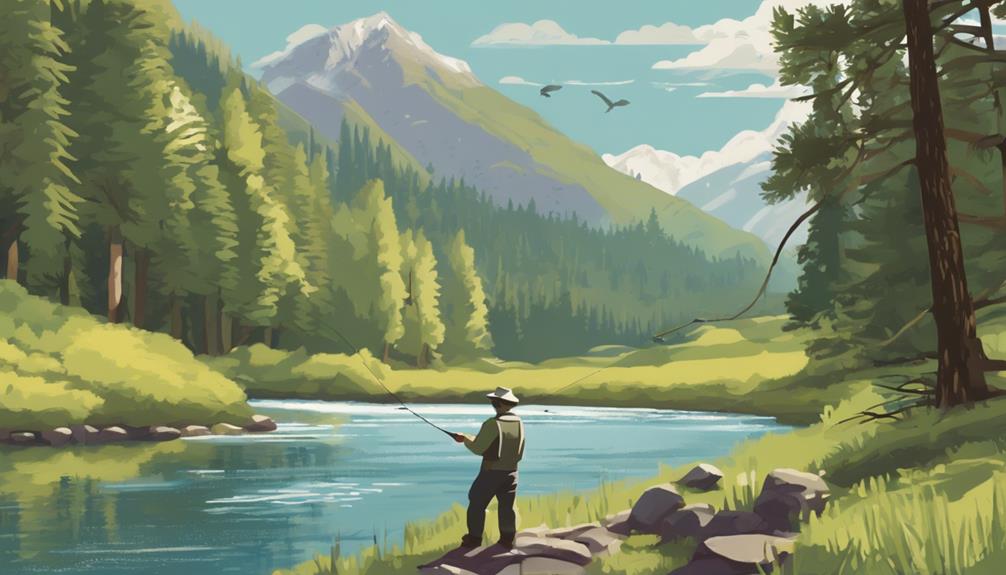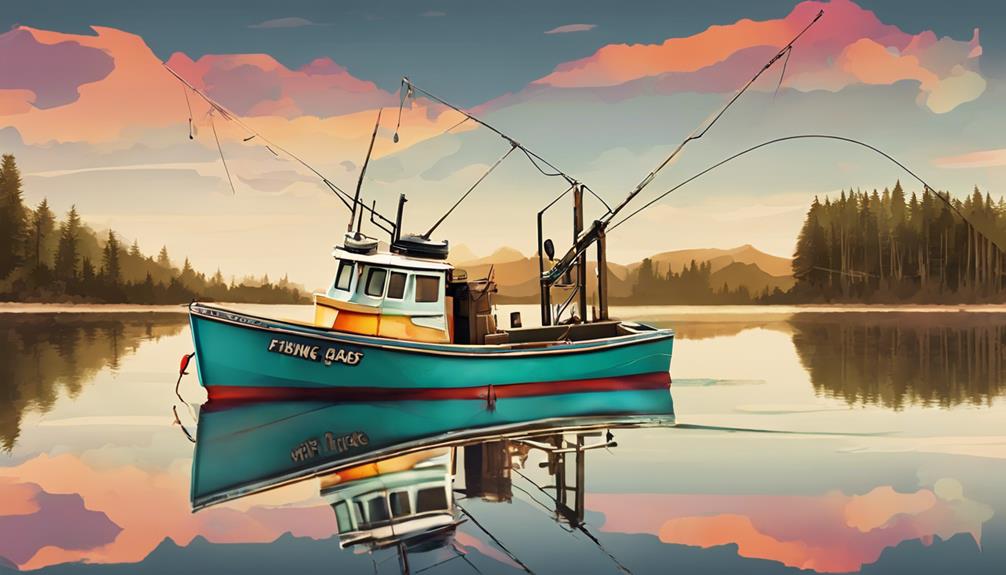You may not be aware of the intricate regulations governing fishing catch size and quantity. Understanding these rules is crucial for preserving fish populations and ensuring sustainable fishing practices.
From size limits for specific species to enforcement measures, each regulation plays a vital role in maintaining ecological balance.
As you navigate the waters, knowing these 9 key regulations will not only keep you compliant but also contribute to the conservation of marine life.
Size Limits for Specific Fish Species
When fishing for specific fish species, you must adhere to size limits set by regulations to protect the population and ensure sustainable fishing practices. These regulations aim to maintain healthy fish stocks and prevent overfishing. Minimum sizes are put in place to allow fish to reach maturity and reproduce before being caught, thus sustaining the population. By respecting these size limits, you contribute to the long-term health of the species and the overall ecosystem.
On the other hand, there are also maximum limits that you need to be aware of while fishing. These limits prevent the excessive harvesting of large fish, which are often important for breeding and maintaining genetic diversity within the population. By not exceeding the maximum limits, you help in preserving the balance within the fish community and allow for the continuation of natural selection processes.
It is crucial to familiarize yourself with the specific size limits for the fish species you're targeting before heading out to fish. This knowledge not only ensures that you're compliant with the regulations but also demonstrates your commitment to responsible angling practices. By following these regulations, you play a vital role in conserving fish populations for future generations to enjoy.
Daily Bag Limits for Anglers
Adhere to daily bag limits as a responsible angler to help conserve fish populations and promote sustainable fishing practices. Daily bag limits are restrictions set by fisheries management to control the number of fish an angler can harvest in a single day. By adhering to these limits, you contribute to conservation efforts and ensure the sustainability of fish stocks for future generations.
Daily bag limits play a crucial role in recreational fishing, as they prevent overfishing and help maintain healthy fish populations. When anglers respect these limits, they support conservation efforts aimed at preserving marine ecosystems and biodiversity. By following the regulations, you actively participate in sustainable practices that have long-term conservation benefits.
Exceeding daily bag limits can have detrimental effects on fish populations, disrupting the delicate balance of marine ecosystems. Overharvesting can lead to a decline in fish stocks, affecting not only the target species but also their predators and prey. By staying within the designated limits, you help maintain the natural equilibrium of the aquatic environment and support the well-being of various marine species.
Slot Limits for Catch Size
Respecting slot limits for catch size ensures sustainable fishing practices and contributes to maintaining balanced fish populations. Slot limits refer to regulations that dictate the size range of fish that can be kept, allowing fish below or above a certain length to be released. By implementing slot limits, authorities aim to protect fish populations and promote ecosystem balance.
These regulations are crucial for the long-term health of fish populations. By setting minimum and maximum size limits, slot limits help prevent overfishing of juvenile fish that are essential for maintaining healthy population levels. Releasing fish that fall within the slot size range allows them to grow and reproduce, contributing to the replenishment of the fish population.
Maintaining ecosystem balance is another key benefit of slot limits for catch size. Fish play a vital role in the aquatic ecosystem, and their populations need to be carefully managed to prevent disruptions in the food chain and overall ecosystem health. By allowing fish to reach maturity before being harvested, slot limits help preserve the natural balance of predator-prey relationships and ensure the sustainability of marine environments.
Regulations on Trophy Fish
Effective management of trophy fish populations is essential for ensuring sustainable recreational fishing practices and preserving the integrity of aquatic ecosystems. Trophy fish, often the larger and older individuals of a species, play a crucial role in maintaining healthy fish populations and genetic diversity. To regulate the harvesting of trophy fish responsibly, various trophy fish regulations and conservation efforts have been implemented:
- Minimum Size Limits: Setting minimum size limits ensures that fish have the opportunity to reach maturity and contribute to the reproductive success of their species before being harvested.
- Bag Limits: Imposing bag limits on trophy fish helps prevent overfishing and allows for more individuals to reach trophy size, enhancing the overall fishing experience for anglers.
- Seasonal Closures: Implementing seasonal closures for specific species during their spawning periods protects vulnerable populations and ensures their continued reproduction.
- Special Permits: Requiring special permits for harvesting trophy fish can help track the impact of fishing pressure on these populations and inform future conservation strategies.
Catch and Release Policies
Consider implementing catch and release policies to promote the conservation of fish populations and sustainable angling practices. By releasing fish back into the water, you contribute to the conservation benefits by allowing them to reproduce and maintain healthy population levels. This practice aligns with ethical considerations of respecting the environment and ensuring the survival of various fish species for future generations.
Angler education plays a crucial role in the success of catch and release policies. Understanding proper catch handling techniques, such as using barbless hooks and minimizing air exposure, can significantly increase the survival rates of released fish. Through education initiatives, anglers can develop a deeper appreciation for the ecosystem and their role in preserving it.
Community involvement is key in fostering a culture of catch and release among anglers. Organizing workshops, seminars, or events focused on sustainable fishing practices can help spread awareness and encourage participation in conservation efforts. By engaging with local angling communities, you can collectively work towards the goal of maintaining thriving fish populations and preserving aquatic habitats.
Incorporating catch and release policies into your fishing practices not only benefits the environment but also enhances the overall angling experience. Remember, your actions today can have a lasting impact on the future of fishing and the preservation of aquatic ecosystems.
Seasonal Catch Restrictions
Implement seasonal catch restrictions to manage fishing activities and protect vulnerable fish populations during critical periods of their lifecycle. These restrictions are essential to ensure sustainable fishing practices and the long-term health of marine ecosystems. By regulating fishing activities based on seasonal variations, authorities can mitigate the impact of overfishing and allow fish populations to replenish effectively.
- Fishing Zone Restrictions: Establishing specific fishing zones during different seasons can help prevent overexploitation in certain areas, allowing fish stocks to recover and ensuring a more balanced ecosystem.
- Seasonal Closures: Temporarily closing fishing grounds during critical periods, such as spawning seasons, can safeguard vulnerable fish populations and contribute to their reproductive success.
- Impact of Climate Change: With the effects of climate change altering fish habitats and migration patterns, implementing seasonal catch restrictions becomes even more crucial to adapt to these changes and protect fish populations from further decline.
- Catch Size Restrictions: Setting limits on the size and quantity of fish that can be caught during different seasons helps prevent the depletion of larger, more reproductively significant individuals, supporting the overall sustainability of fish stocks.
Special Regulations for Protected Species

To ensure the protection of vulnerable fish populations, it's imperative to establish special regulations for protected species within fishing catch size regulations. Conservation strategies play a crucial role in safeguarding endangered species and their habitats. By implementing specific catch limits, fishing activities can be managed to prevent overexploitation of these at-risk populations.
Protected species are often designated as such due to their declining numbers or critical role in the ecosystem. Preservation efforts focus on promoting the recovery of these species by limiting the number that can be caught. These regulations help maintain the delicate balance within marine ecosystems and support biodiversity.
Furthermore, protecting habitats where these endangered species reside is equally important. By establishing catch limits for these species, fishing practices can avoid negatively impacting their habitats and breeding grounds. This approach ensures that future generations can also enjoy the presence of these unique marine creatures.
Enforcement of regulations regarding protected species is crucial. Monitoring catch sizes and quantities is essential to guarantee compliance with conservation measures. By working together to respect these regulations, fishermen can contribute to the long-term sustainability of fish populations and the overall health of marine environments.
Enforcement of Catch Limits
Enforce catch limits effectively to ensure compliance with conservation measures and protect vulnerable fish populations from overexploitation. When it comes to enforcing catch limits, several challenges and strategies need to be considered:
- Compliance Challenges: Monitoring and enforcing catch limits can be challenging due to the vastness of the ocean and the difficulty of tracking individual fishing vessels. Some fishermen may also be tempted to exceed catch limits to maximize their profits, especially in regions with weak enforcement measures.
- Enforcement Strategies: To address these challenges, authorities can implement technologies such as vessel monitoring systems and satellite surveillance to track fishing activities more effectively. Random inspections at sea and in ports can also deter fishermen from exceeding catch limits.
- Economic Impact: Enforcing catch limits can have economic implications, especially for small-scale fishermen who rely on fishing for their livelihoods. It's crucial to strike a balance between conservation efforts and the economic needs of fishing communities to ensure sustainable practices.
- Stakeholder Perspectives: Engaging with stakeholders, including fishermen, conservation groups, and government agencies, is essential in developing effective enforcement strategies. By involving all parties in the decision-making process, it's possible to create regulations that are both environmentally sound and socially acceptable.
Frequently Asked Questions
What Are the Penalties for Exceeding Catch Size and Quantity Limits While Fishing?
If you exceed catch size and quantity limits while fishing, penalty enforcement measures may be taken against you. Authorities closely monitor catches to ensure compliance. Penalties could include fines, license suspensions, or even confiscation of equipment.
It's crucial to follow regulations to protect marine life and sustain fisheries. Always be mindful of your catch size and quantity to avoid facing these consequences.
Are There Any Exceptions to the Catch Size and Quantity Limits for Certain Fishing Locations or Events?
When fishing, you might wonder if there are exceptions to catch size and quantity limits, especially for tournaments or special events. In some cases, certain locations or events may have different regulations in place.
For tournaments, organizers often obtain permits allowing participants to keep larger catches within set guidelines. Similarly, special events might've unique rules to accommodate the nature of the activity.
Always check local regulations to ensure compliance.
How Do Conservation Efforts Play a Role in Determining Catch Size and Quantity Regulations?
Conservation efforts have a significant impact on determining catch size and quantity regulations. By implementing sustainability measures, authorities aim to protect fish populations and maintain a balanced ecosystem.
Monitoring fishing practices and setting limits help ensure that marine resources aren't overexploited. Compliance with these regulations is crucial for the long-term health of aquatic environments and the preservation of fish species for future generations.
Are There Any Guidelines for Anglers to Properly Measure and Document Their Catch to Ensure Compliance With Regulations?
When fishing, it's essential to follow guidelines for proper measurement and documentation of your catch to ensure compliance with regulations. Not doing so can lead to penalties.
Exceptions may apply based on conservation efforts and location variations between freshwater and saltwater regulations. Make sure you understand and adhere to the rules to help protect marine life and sustain healthy fish populations.
How Do Catch Size and Quantity Limits Vary Between Freshwater and Saltwater Fishing Regulations?
When you compare freshwater and saltwater fishing regulations, you'll notice differences in catch size and quantity limits. Understanding these variations is crucial for compliance.
Different measuring techniques may be required for each type of water body. Make sure to document your catches accurately to adhere to the rules.
Conclusion
Now that you know the key regulations on fishing catch size and quantity, make sure to always follow them to help protect our fish populations.
By adhering to size limits, bag limits, and other regulations, you can ensure sustainable fishing practices for future generations to enjoy.
Remember, it's important to respect these rules to help maintain a healthy and balanced ecosystem for all.
Happy fishing!



